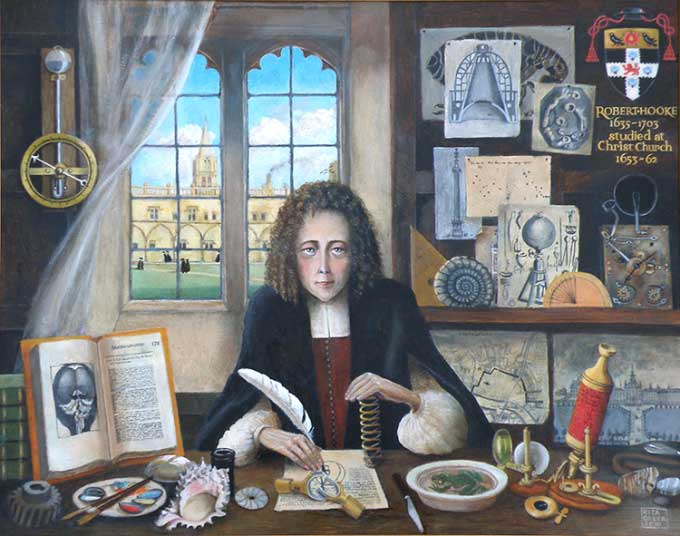The life of Robert Hooke - The scientist who discovered the cell
Robert Hooke was born on July 18, 1635 on the Isle of Wight, an island off the south coast of England. As a child, suffering from severe smallpox and too ill to attend school, he spent most of his childhood painting in his bedroom. At the time, Hooke also displayed amazing mechanical ability, building wooden clocks and toy boats with cannons.
In his late teens, after his father's death, Hooke went to London and enrolled at Westminster School, where he received a solid academic education in Latin, Greek and Hebrew, while also receiving training. created to be a musical instrument maker. From there, he discovered that his talents extend beyond the realm of painting, according to ThoughtCo.

Painting of Robert Hooke based on a friend's description.
Hooke displayed remarkable competence in many fields, but his most famous discovery was the discovery of cells in 1665. This achievement was also achieved by the microscope, which he himself improved on earlier designs based on on a complex microscope. He placed three lenses in sequence to magnify the image and add light for better observation.
These improvements allowed Hooke to see "miracles" when he placed a piece of cork under a microscope. The scientist detailed his observations of this small and unprecedented world in his book Micrographia. For Hooke, cork looks as if it were made of tiny pores, which he calls "cells," according to National Geographic.
"I can clearly see that it's all perforated and porous, like a honeycomb, but its holes are uneven. These pores, or cells, are actually microscopic holes. the first that I have ever seen, and probably no one has ever seen, because I have not come across any reference to them before," Hooke wrote in Micrographia.
The Micrographia is also filled with other intricate sketches of the tiny world Hooke observed, from hexagonal snowflakes to mold spores, which, up close, resemble swaying tulips. in the wind.

Robert Hooke's Improved Microscope.
He was also the first to examine different types of fossils with a microscope and suggested in his Micrographia that fossils form when certain species are pushed to a place where they are buried by mud, clay, petrified water, or some other substance caused by a cataclysmic event, flood, or earthquake.
His microscopic observations also show how mosquitoes and lice feed on blood.
Hooke once discovered a law of physics that was later named after him. Hooke's law states that the force required to stretch or compress a spring is proportional to the distance it is stretched.
Following this success, he improved five main meteorological instruments, including barometers, thermometers, hydrometers, rain gauges and anemometers, according to Live Science.
In the field of astronomy, Hooke discovered the fifth star in the "trapezoid" of the constellation Orion in 1664. During his observations of the night sky, he analyzed the planets and was the first to propose it. hypothesized that Jupiter rotates on an axis. Later, in the 19th century, his sketches of Mars were used to calculate the rotational speed of the celestial body.
Died and never married
Hooke kept a diary in which he discussed his illness extensively. Though not as literary as Samuel Pepys' diary, it did describe in great detail about everyday life in London after the Great Fire. Hooke died on March 3, 1703, of scurvy and several other unknown illnesses. He was never married and had no children.
Hooke was a brilliant scientist, but also difficult and impatient, which prevented him from achieving real success in the field of mathematics. Many of Hooke's ideas were inspired and later completed by others both inside and outside the Royal Society of London, such as pioneering microbiologist Antoni van Leeuwenhoek (1632 - 1723), geographer William Dampier (1652 - 1715), geologist Niels Stenson (1638 - 1686), and even Isaac Newton (1642 - 1727), who was at odds with Hooke.
When the Royal Society of London published Newton's "Principia" in 1686, Hooke accused Newton of plagiarism. According to the journal Science Focus, Newton's new law explains why "all celestial bodies have a force of attraction or gravity directed toward their center," but Hooke wrote these words decades ago.
Newton denied any plagiarism, but many believe that Newton may have turned Hooke's exact description into a mathematical model. This incident affected Newton so much that he had to stop publishing "Optics" until Hooke's death.
- Robert Hooke (1635-1703): The person who discovered the cell
- Revealing the mysterious and mysterious disease of scientist Charles Darwin
- Scientist found HIV virus rejected for Nobel Prize
- Salary of world famous scientists
- Japanese scientist and stem cell story
- The birth of the microscope
- Lemongrass collection technology for the first time in Vietnam by 65-year-old scientist
- LEARN ABOUT ORIGINAL CELL (Part 3)
- The ocean is not the place where cell life begins
- Japanese stem cell specialist committed suicide because he was suspected of the idea
- The father of in vitro fertilization techniques died
- Add a new allegation of germ cell scandal
 The Indian prophet prodigy warned 3 events and what will happen on April 13, 2022
The Indian prophet prodigy warned 3 events and what will happen on April 13, 2022 Top 8 youngest professors in the world: Teaching university at the age of 18
Top 8 youngest professors in the world: Teaching university at the age of 18 Elena Cornaro Piscopia - The world's first female doctor of philosophy
Elena Cornaro Piscopia - The world's first female doctor of philosophy The ancient Greek philosopher was executed for understanding the Moon
The ancient Greek philosopher was executed for understanding the Moon